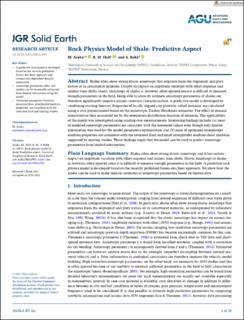| dc.contributor.author | Asaka, Michinori | |
| dc.contributor.author | Holt, Rune Martin | |
| dc.contributor.author | Bakk, Audun | |
| dc.date.accessioned | 2022-02-04T08:59:38Z | |
| dc.date.available | 2022-02-04T08:59:38Z | |
| dc.date.created | 2021-09-07T14:30:06Z | |
| dc.date.issued | 2021 | |
| dc.identifier.citation | Journal of Geophysical Research (JGR): Solid Earth. 2021, 126 (9), 1-26. | en_US |
| dc.identifier.issn | 2169-9313 | |
| dc.identifier.uri | https://hdl.handle.net/11250/2977073 | |
| dc.description.abstract | Shales often show strong elastic anisotropy that originate from the alignment and platy nature of its constituent minerals. Despite its impact on AVO (Amplitude Variation with Offset) response and seismic time-shifts, elastic anisotropy of shales is, however, often ignored since it is difficult to measure enough parameters in the field. Being able to correctly estimate anisotropy parameters of shales can therefore significantly improve seismic reservoir characterization. A predictive model is developed by combining existing theories. Properties of locally aligned clay platelets, called domains, are calculated using a rock physics model based on the anisotropic Hashin-Shtrikman estimates. The effect of domain orientation is then accounted for by the orientation distribution function of domains. The applicability of the model was investigated using existing core measurements. Interesting findings include: (1) Most of modeled anisotropy parameters are consistent with the measured values even though only limited information was used for the model parameters optimization, (2) most of optimized interplatelet medium properties are consistent with the saturated fluid and small interplatelet medium shear modulus suggested by existing studies. These findings imply that the model can be used to predict anisotropy parameters from limited information. | en_US |
| dc.language.iso | eng | en_US |
| dc.publisher | John Wiley & Sons Ltd. | en_US |
| dc.relation.uri | https://agupubs.onlinelibrary.wiley.com/doi/10.1029/2021JB021993 | |
| dc.rights | Navngivelse 4.0 Internasjonal | * |
| dc.rights.uri | http://creativecommons.org/licenses/by/4.0/deed.no | * |
| dc.title | Rock physics model of shale: Predictive aspect | en_US |
| dc.type | Peer reviewed | en_US |
| dc.type | Journal article | en_US |
| dc.description.version | publishedVersion | en_US |
| dc.rights.holder | © 2021. The Authors. This is an open access article under the terms of the Creative Commons Attribution License, which permits use, distribution and reproduction in any medium, provided the original work is properly cited. | en_US |
| dc.source.pagenumber | 1-26 | en_US |
| dc.source.volume | 126 | en_US |
| dc.source.journal | Journal of Geophysical Research (JGR): Solid Earth | en_US |
| dc.source.issue | 9 | en_US |
| dc.identifier.doi | 10.1029/2021JB021993 | |
| dc.identifier.cristin | 1932101 | |
| dc.relation.project | Norges forskningsråd: 294369 | en_US |
| dc.relation.project | Norges forskningsråd: 294404 | en_US |
| dc.source.articlenumber | e2021JB021 | en_US |
| cristin.ispublished | true | |
| cristin.fulltext | original | |
| cristin.qualitycode | 2 | |

